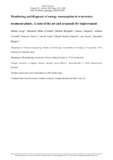JavaScript is disabled for your browser. Some features of this site may not work without it.
| dc.contributor.author | Longo, Stefano | |
| dc.contributor.author | d’Antoni, Benedetto Mirko | |
| dc.contributor.author | Bongards, Michael | |
| dc.contributor.author | Chaparro, Antonio | |
| dc.contributor.author | Cronrath, Andreas | |
| dc.contributor.author | Lema, Juan M. | |
| dc.contributor.author | Mauricio-Iglesias, Miguel | |
| dc.contributor.author | Soares, Ana | |
| dc.contributor.author | Hospido, Almudena | |
| dc.contributor.author | Fatone, Francesco | |
| dc.date.accessioned | 2016-10-26T10:59:03Z | |
| dc.date.available | 2016-10-26T10:59:03Z | |
| dc.date.issued | 2016-08-09 | |
| dc.identifier.citation | Longo S, d’Antoni BM, Bongards M et al. Monitoring and diagnosis of energy consumption in wastewater treatment plants. A state of the art and proposals for improvement, Applied Energy, Volume 179, Issue 1, October 2016, pages 1251 – 1268 | en_UK |
| dc.identifier.issn | 0306-2619 | |
| dc.identifier.uri | http://dx.doi.org/10.1016/j.apenergy.2016.07.043 | |
| dc.identifier.uri | http://dspace.lib.cranfield.ac.uk/handle/1826/10871 | |
| dc.description.abstract | In response to strong growth in energy intensive wastewater treatment, public agencies and industry began to explore and implement measures to ensure achievement of the targets indicated in the 2020 Climate and Energy Package. However, in the absence of fundamental and globally recognized approach evaluating wastewater treatment plant (WWTP) energy performance, these policies could be economically wasteful. This paper gives an overview of the literature of WWTP energy-use performance and of the state of the art methods for energy benchmarking. The literature review revealed three main benchmarking approaches: normalization, statistical techniques and programming techniques, and advantages and disadvantages were identified for each one. While these methods can be used for comparison, the diagnosis of the energy performance remains an unsolved issue. Besides, a large dataset of WWTP energy consumption data, together with the methods for synthesizing the information, are presented and discussed. It was found that no single key performance indicators (KPIs) used to characterize the energy performance could be used universally. The assessment of a large data sample provided some evidence about the effect of the plant size, dilution factor and flowrate. The technology choice, plant layout and country of location were seen as important elements that contributed to the large variability observed. | en_UK |
| dc.language.iso | en | en_UK |
| dc.publisher | Elseveir | en_UK |
| dc.rights | Attribution-NonCommercial-NoDerivatives 4.0 International | |
| dc.rights.uri | http://creativecommons.org/licenses/by-nc-nd/4.0/ | |
| dc.subject | Wastewater treatment | en_UK |
| dc.subject | Energy efficiency | en_UK |
| dc.subject | Benchmarking | en_UK |
| dc.subject | KPI | en_UK |
| dc.subject | OLS | en_UK |
| dc.subject | DEA | en_UK |
| dc.title | Monitoring and diagnosis of energy consumption in wastewater treatment plants. A state of the art and proposals for improvement | en_UK |
| dc.type | Article | en_UK |
Files in this item
This item appears in the following Collection(s)
-
Staff publications (SWEE) [2825]

